As we first outlined early last year:
Plans for 20 new residential buildings to rise on a vacant 7-acre slice of land fronting Jamestown Avenue, a former Candlestick Park parking lot which overlooks the massive Candlestick Point redevelopment which is now underway below, have been drafted by Hunt Hale Jones Architects for Strada Investment Group.
As envisioned, the 20 buildings would rise up to 40 feet in height, the maximum for which the site is zoned, and yield a total of 122 condominiums, ranging in size from 1,200 to 1,600 square feet, with 81 two bedrooms and 41 threes, a network of shared open spaces, and parking for a total of 180 cars (including 17 spaces for guests).
And while the proposed Jamestown development sits outside the official boundaries Lennar’s Candlestick Point project, it’s positioned to leverage the Point’s future outdoor spaces, infrastructure and Bus Rapid Transit (BRT) line.
Since refined by Hunt Hale Jones and newly rendered below, the 122 proposed units now range in size from 1,100 to 1,550 square feet, with 153 off-street parking spaces for residents and 17 spaces for guests.
And while a number of neighbors have raised their concerns with the parking ratio for the 285-bedroom project, San Francisco’s Planning Department is recommending the 853 Jamestown Avenue project, the RH-2 site for which is zoned for a maximum of 100 code-compliant units, if theoretically subdivided into a potential 50 lots, and a required Density Bonus for the development as proposed be approved San Francisco’s Planning Commission tomorrow afternoon.
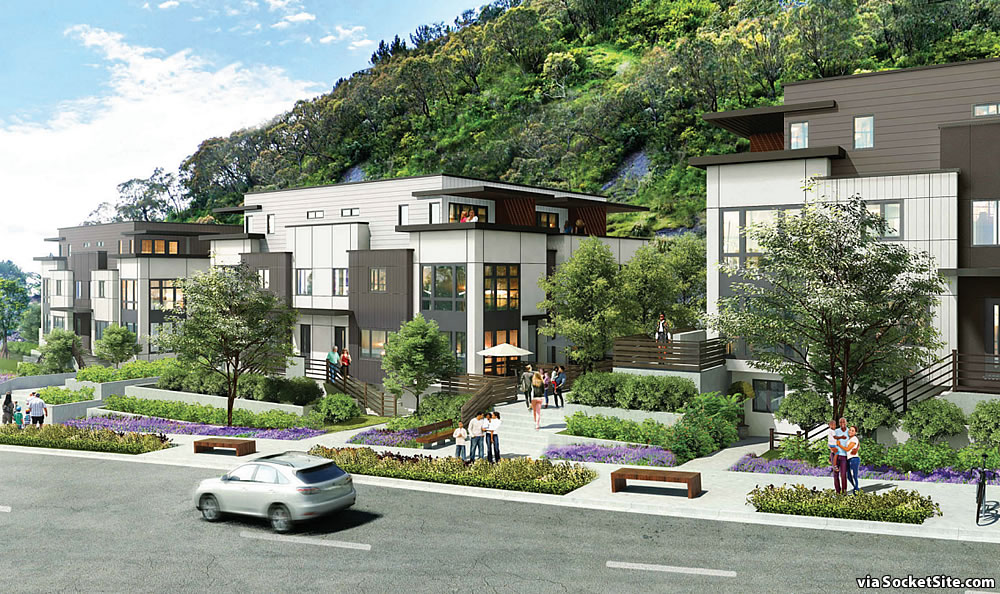
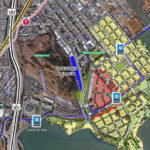
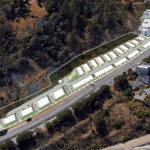
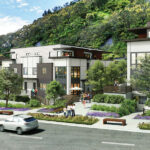
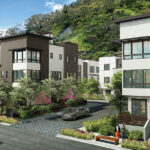
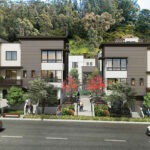
This area is going to be the next gentrification controversy / sadness. With thousands of new construction units at market rate coming online in coming decades, close freeway access to tech companies down the peninsula, the Central Subway providing direct access to downtown, the best weather in the city, single family homes ripe for being flipped, and a commercial corridor to be invested in, gentrification is near guaranteed.
This is going to be a sad one. The black population in SF will be sub 3% once this is done.
The surest way to gentrify a place is to NOT build housing.
The reason that formerly lower and middle class neighborhoods throughout SF like the “Panhandle”, “Haight Ashbury”, “Noe Valley”, “Potrero Hill”, “Cole Valley” are thoroughly gentrified is because apartments were outlawed in these neighborhoods in the 70’s.
Making the creation of more naturally affordable housing typologies (i.e., apartments rather than single family homes) illegal on account of the massive Citywide downzoning in the 1970’s (led by, ironically, so-called “housing activists” like Calvin Welch) has led directly to a chronic and continuing housing shortage and the resulting skyrocketing housing costs.
If one really cares about the “black population in SF” and, more generally, those of modest means, you would support general up zoning throughout SF (especially the West Side where 70% of the City’s residentially zoned land exists but one is only allowed to build a maximum of 1 to 2 dwelling units per lot) and the creation of massive amounts of new housing.
The tragedy of this particular property is that it is zoned at the lowest density RH-1 (i.e., for single family housing) whereas it should be zoned for apartment buildings.
It’s actually zoned RH-2 (as noted above).
Sorry, my bad; it’s zoned for duplexes.
Still a massive waste of precious urban land.
Need housing, absolutely. Market rate housing, nope. All it does is provide for those who do not live in the neighborhood, but can afford the higher cost of the condo or the rent. And as far as all the existing housing, that gets rented or purchased by new people as well, as they can afford it and residents can’t. In the last 20 years 60-70% of the existing housing lived in by Latinos is now folks that work for Google or Apple. Bernal Hill is the same.
if a lot of new construction happened, that 60-70% would be lower as new wealthier residents wouldve moved in the newer construction instead of taking existing housing stock. the more you restrict the stock, the more wealthy people take over current stock. simple concept
If I didn’t know any better, from the replies to my comment you’d think I made my reply on the National Review. Wow, Look there is very little restriction on Market rate housing to be built in SF, Candlestick Point/Hunters Point Shipyard, 9300 units; Treasure Island 8200 units; Park Merced 7900 units; Potrero Power Station 2700 units; Pier 70, 1600 units. This is the tip of the iceberg. Development is about Capital, and banks provide that capital. But who provides the capital to the banks? Its the government! So what we are debating here is not the free market, it’s how does the government fund this capital to build housing for a larger section of our population than just those at the top? So more people get a piece of the pie?
Allowing housing on literal toxic wastelands and almost none on 70% of residential land is not “little restriction on Market rate housing.” This is before the crazy impact fees which themselves are comparable with the all in cost of construction in other places in the country.
That’s what happens when market rate housing is constricted.
What are you going to do prevent people from buying or renting homes based on the color of their skin or where they work?
Michael,
Do you live in subsidized housing?
If not, you live in market rate housing.
If it’s the latter, why do you want to deny to others, that which you enjoy?
It’s twisted view point that people who can afford to pay for their housing don’t deserve it and people who can’t pay, deserve expensive subsidized housing paid for by others. It does not compute, like Marxism or the Cultural Revolution did not.
But if people move there they will be residents also… I mean really, even tent squatters are called “residents” now…..
Wrong, wrong, wrong. We need much, much more market rate housing. We also need need to pair that with strong affordable housing mandates (public, very low/low income, and ideally middle income) that disincentivize or ban building it offsite, in other neighborhoods than the project itself, or just throwing money into a fund. The projects in Potrero and Sunnydale are reasonably good examples of this, but there needs to be much more, including in ways that isn’t just replacing public housing.
YES.YES, YES. This ^^^^^^^^^
Neurotic white people recommending that market forces be suspended in order to maintain the population of African Americans in the exact proportion based upon an arbitrary point in time. No acknowledgement that these individuals may have chosen of their free will to leave dangerous or decaying neighborhoods in search of a better life. After all, without the benevolence of the white liberal, black folks can’t make it here.
I generally agree with all of your points, but this is an unusual situation. This southern portion of the Bayview is currently, in broad strokes, 50% non-gentrified housing and 50% empty lots right now. By building market rate condos / apts on the empty lots, the intensity of pressure on the current housing will be even more intense.
Building new housing does not “intensify pressure” on the current housing — it does the exact opposite as others in this comments section have noted and every economist will reiterate.
NOT building housing is what creates pressure on the existing housing stock, i.e., those with more money out bid those with less money as the compete for the limited amount of existing housing.
This is pretty basic stuff and it’s mind boggling that there are many people who do not understand (or refuse to acknowledge) the basic mechanisms of markets.
Unfortunately, it’s actually not that basic nor “econ 101,” which actual economists should know.
Development typically raises prices/rents in an area as newer homes tend to fetch higher prices, raising the neighborhood comps and attracting “those with more money” than before. At the same time, the increased density and demographics of the area leads to more local services and investment, which further raises the relative desirability of the neighborhood.
Or quite simply, the gentrification of a neighborhood tends to increase prices while the gentrification of a generic product typically has the opposite effect.
Socket, your comment needs citations.
Responding to the Socketsite (ie editor) post below: As editor of this site you need to be less cavalier. I won’t take a position on the reasonable debate around whether new market rate housing raises or lowers surrounding rents (there is evidence for both points of view), but you should not oversimplify like you did here. Maybe you should do a whole, well researched post on this issue, but this is not a good response.
I’m pro-housing / pro-density and agree with your belief system. I’m in favor of this project in its current form.
However, when you build tens of thousands of market rate units (aesthetically nicer, landscaping, lighting) and acres of waterfront parkland, directly next to non-gentrified housing, it’s going to be more intense pressure on that housing than if you say, added one random 12 story building to a non-gentrified area. It is what it is.
candlestick could be a contender for worst weather in the city, but certainly not best. Did you ever go a baseball game there?
Possibly a bit windy, but isn’t the Southeastern portion of SF generally the warmest and sunniest?
windiest area in the whole city. fog sometimes here when its sunny in the mission, but mostly its a massive wind problem. Went to a lot of very cold giants games there
The wind on 101 is the worst right there……
Yes. It’s generally the warmest and the sunniest. We do get strong winds most days, around 4pm. They die down after a few hours. Fog is rare. Bayview is a large neighborhood of which the former stadium is only a part.
But this development is specific regarding Candlestick. The area adjacent to that stadium doesn’t have as good of weather as if you go farther North.
A yes, Candlestick famously has the city’s best weather…
You are definitely the first, and probably only, person to believe that the Central Subway provides “Direct” service from Candlestick to downtown. It takes a solid 45 minutes for the T to amble from Le Conte to Embarcadero, plus the ten minutes you’d need to walk from this location to the Le Conte platform. After they redirect it into the subway you’ll need to transfer to get downtown, as the T will take you to Union Square instead. You can transfer to another metro like at Union Square, if you just hate yourself a lot, but it’s a half a mile walk between Union Square and Civic Center metro, platform-to-platform. You could also change for the N at 4th & King, again, if you loathe yourself.
If you believe anything labeled “future Muni BRT stop” you are either using a generous interpretation of “future” or you haven’t lived here very long.
Between King, Bryant, Moscone, Union Square and Chinatown (Financial District) stops, the Central Subway will provide tons of access for commuters. Yes you’ll have to tack on 5-10 minute walks on either side – not transfers which I agree suck – but I don’t see people minding that.
The fact that even with the state density bonus, we only get 122 units on a 7 acre site is insane. I’m not saying we need high-rises, but why not 6-8 story buildings??
Agreed. Idiotic zoning.
agree, this would be ideal for 8-12 story buildings
plans indicate it is 3.5 acres net buildable, the rest is the sloped hillside
That’s “suitable for development per the Project Sponsor” versus buildable (but at a higher average cost).
carlos have you ever been to L.A.? If Strada Investment Group really wanted to build the maximum number of homes they could do it on sloped hillside, it just means they’d have to do some real engineering (foundation/shoring) and not take the path of least resistance. As it stands they are optimizing ROI for their investors, let’s get real here.
I live in a house which was built to maximize ROI for investors. It’s fine. Welcome to America, most pensioners are paid with such profits.
I hope the unit construction is better than on the other side of the hill (Harney Way). I have visited that area and the outside areas look awful thanks to all kinds of rust and corrosion. This includes the elevators, the door knobs, rails and basically any metal exposed to the air. If the builders don’t do something to protect the exposed metal, it will look terrible in 5-10 years.
It’s funny how it’s “gentrification” when construction occurs, and “disinvestment” when it doesn’t.
Not sure I would qualify this as the best weather in town. Sunny probably, but really windy (like Twin Peaks and many other higher-up nice neighborhoods). Actually, if the buildings are tucked up behind Bayview Park enough, they may be well-protected. With nice views.
Density and size is consistent with the adjacent neighborhood and with buildings that one can actually afford to build and run.
Anyone who thinks BLM should be supporting this and more housing everywhere in the city.
Good luck to the builders.
Can we just dispense with the notion that there’s any course of action that doesn’t result in displacement?
If you don’t build any additional housing in an area (and especially if you improve amenities in it at the same time), then displacement will occur as buyers look for bargains and lower entry points.
If you build a bunch of new housing in an area (and especially if none or very little of it is designated for lower income people), then you may avoid some of the bargain hunting displacement but you’ll get some upward price pressure on existing units as the area becomes more desirable, which also leads to some displacement.
The latter is still broadly preferable. It generally speaking will improve conditions, provide more housing stock at market rate and ‘affordable’ rates, and likely lead to proportionally less involuntarily turnover in a neighborhood’s population. There are no perfect solutions, and there never will be. But refusing to build or banning new construction is ultimately the worst outcome for the largest number of people in the long term.
Exactly.
A course(s) of action that does not cause displacement? For one rent control. Two ADU’s, Accessory Dwelling Units. Three Apartment building conversion where tenants, by law, have an option to buy that unit.
Rent control causes displacement! This has been extensively studied. Someone might be in a rent-controlled apartment for a few years longer than they might otherwise, but then when other factors cause them to need to move, they can’t afford to live anywhere. Plus, when cities enact rent control, the number of units on the market goes down 5-15% (this is exactly what happened in SF).
The displacement is due to gentrification and the replacement of currently affordable units with higher-cost units by the flippers, developers and others in the “real estate game” who flood into cities in order to exploit wage earners who for whatever reason can’t afford to purchase a home. Cities enact rent control as a reaction to this phenomenon — rent control doesn’t cause it — the action of the capitalist system and the greed of those trying to get rich from real estate does.
Would you please educate me? What extensive studies, specifically, are you referring to?
It’s good to note though that this is an area of the city with a lot of rent controlled housing, probably a great majority of it, which I would argue is why it hasn’t seen much change since the onset of the tech boom. I am not so sure if market rate housing in candlestick will cause upward pressure on rent in the adjacent areas for this reason.
“Or quite simply, the gentrification of a neighborhood tends to increase prices while the gentrification of a generic product typically has the opposite effect.”
Dear Socketsite,
What is “gentrification of a generic product”?
I believe what the editor was trying to say – if not quite succeeding – was that if you “gentrify” ( i.e. increase the supply) of a conventional “generic” good – say ‘rice’ – the price will go down … the demand curve will remain unchanged, while the supply curve shifts out, and the equilibrium price drops. But with specifically identifiable products (e.g. housing) increasing the supply may ultimately shift the demand curve as well, so the equilibrium price might actually rise…indeed that’s the thinking behind “gentrification” in the first place: build/rehab better housing and people will want to live there, displacing those there now.
But yes a little more clarity would be nice considering the large number of ESL speakers here (their native tongue being “Realtorese”)
Isn’t the Bus Rapid Transit (BRT) line depending on that bridge that hasn’t been built yet? And that isn’t funded to happen?
If Jeffrey Tumlin is right, and SFMTA can’t afford to run the majority of its existing bus lines, how can a project approval rely on a new bus line on a bridge not yet built with no funding?
I like the project btw.
Public transit could be in big trouble (even bigger than the recent history of hugely-and-bigger-into-eternity operating deficits suggests).
Of course SF isn’t some insignificant, car-dependent backwater like NYC, and the loosener-of-the-Federal-pursestrings DOES hail from here – Mitch’s veto be damned! – but those who actually follow headlines might think about reassessing their outlook…espicailly those who think the ‘Underground-the-38 Society’ actually has chapters outside the city limits
Bayview has nice weather. A couple miles south at candlestick area it is chilly because of fog a good part of the year. Let’s distinguish between the two.
Tell all the people moving out of the city how much more housing the citizens of San Francisco need to build as they pack up the belongings they can fit in their cars and trucks and head out of the city. You want affordable housing, just give your landlord notice and see what kind of offers you get for reduced rent. No need to build more now.
These need to be at least 6-8 stories!
Very chilly weather there in summer due to fog, but just a half mile north of it, there is protection from fog due to mountain, and nice weather. Huge contrast